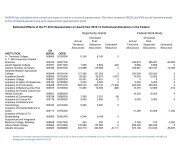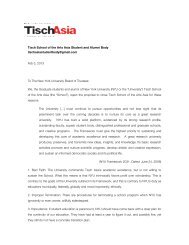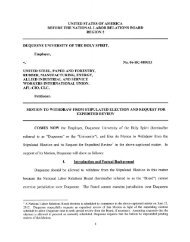survey of admissions directors - Inside Higher Ed
survey of admissions directors - Inside Higher Ed
survey of admissions directors - Inside Higher Ed
Create successful ePaper yourself
Turn your PDF publications into a flip-book with our unique Google optimized e-Paper software.
dents at four-year institutions support aproposed NACAC policy (since placedon hold) that would bar colleges from employingagents paid with commissions forinternational recruiting.Although only a fifth (18.2 percent)<strong>of</strong> the <strong>admissions</strong> <strong>of</strong>ficers at four-year institutionsreport a problem with fabricated<strong>admissions</strong> applications from internationalapplicants, almost half (46.5 percent) believethat agents <strong>of</strong>ten help their clientsfabricate information on their applications.Table 10Recruiting International Students(percentages reporting “yes”)All 4-YearInstitutionsDoes your institution retain agents (paid in full or in part on commission) to recruit international undergraduates? 22.0 24.4 22.2 16.0 17.2 31.3 16.8Is your institution considering the use <strong>of</strong> such agents for international recruiting? 32.5 26.2 48.9 32.0 24.1 39.0 26.1The NACAC draft policy on international recruiting suggests that the same standards that apply to domestic recruiting(no payment based on commission) should apply to international recruiting. Do you agree with the draft NACAC policy? 65.4 72.7 61.7 65.2 69.0 57.0 61.8Are you experiencing a continuing problem with fabrications on international applications? 18.2 27.3 11.4 16.7 31.0 15.2 16.5Do you believe that paid agents <strong>of</strong>ten play a direct role in helping international applicants fabricate information on their applications? 46.5 48.8 50.0 31.8 46.4 39.0 52.9PublicDoctoralPublicMaster’sPublicBacc.PrivateDoctoralPrivateMaster’sPrivateBacc.Application and Enrollment TrendsAdmissions <strong>directors</strong> track the numbers. Key metrics for first-year applicationsand enrollments comparing fall 2011 with 2008 and 2010 suggest thatthe numbers have improved for most institutions over the past three years.Table 11 (on following page) reveals thatfall 2011 application numbers are “muchhigher” for key student populations comparedto fall 2008 and somewhat better thaneven for fall 2010. For example, almostthree-fourths (72.1 percent) <strong>of</strong> four-yearinstitutions and fully half (52.9 percent) <strong>of</strong>community colleges report total first-yearapplications in fall 2011 to be “much higher”than in fall 2008. Across all categoriesshown in Table 11, few institutions report“much lower” applications when they comparedthe numbers for 2011 with either2008 or 2010. In some categories, morethan a third or even half <strong>of</strong> four-year collegesand community colleges also reportthat the numbers <strong>of</strong> applications are muchhigher (e.g., full-time students, low-incomestudents, minority students, and veterans).Similarly, Table 12 reveals the fall2011 enrollment numbers to be “muchhigher” for key student populations comparedto fall 2008 and somewhat betterthan for fall 2010. In general, comparativelyfew institutions report enrollmentdeclines for key populations. Moreover,fully half (51.5 percent) <strong>of</strong> four-year institutionsand a fourth (25.7 percent) <strong>of</strong>community colleges report total firstyear enrollment in fall 2011 to be “muchhigher” than in 2008. The “much higher”numbers fall a bit for fall 2011 vs. 2010,but still reflect gains for many campuses.Issues for Community CollegesAs noted above, the <strong>Inside</strong> <strong>Higher</strong> <strong>Ed</strong> <strong>survey</strong> <strong>of</strong> <strong>admissions</strong> <strong>directors</strong> was actuallytwo separate <strong>survey</strong>s – one for four-year institutions and a second forcommunity colleges. The community college <strong>survey</strong> included several items,discussed below, that were not on the questionnaire for four-year institutions.Conventional wisdom suggests thatduring times <strong>of</strong> economic difficulty, traditional-ageundergraduates may be morelikely than at other times to consider attendingcommunity colleges.As shown in Table 13 (on Page 15), theconventional wisdom appears to be true.2011 SURVEY OF COLLEGE AND UNIVERSITY ADMISSIONS DIRECTORS INSIDE HIGHER ED13






